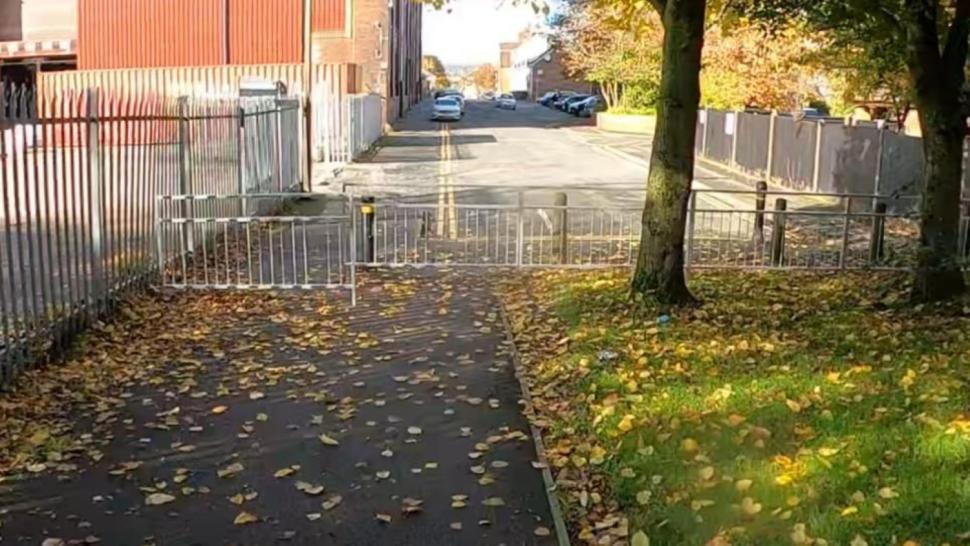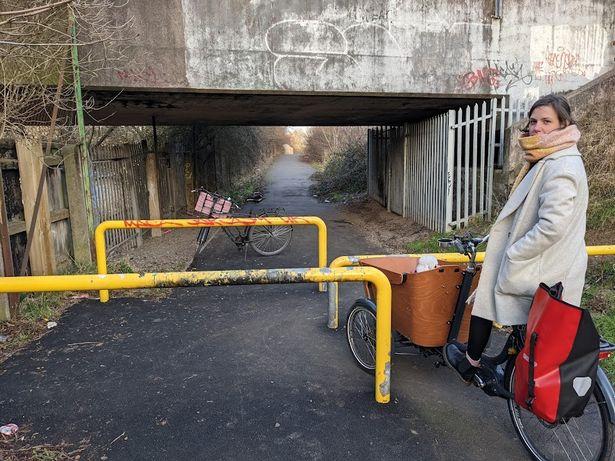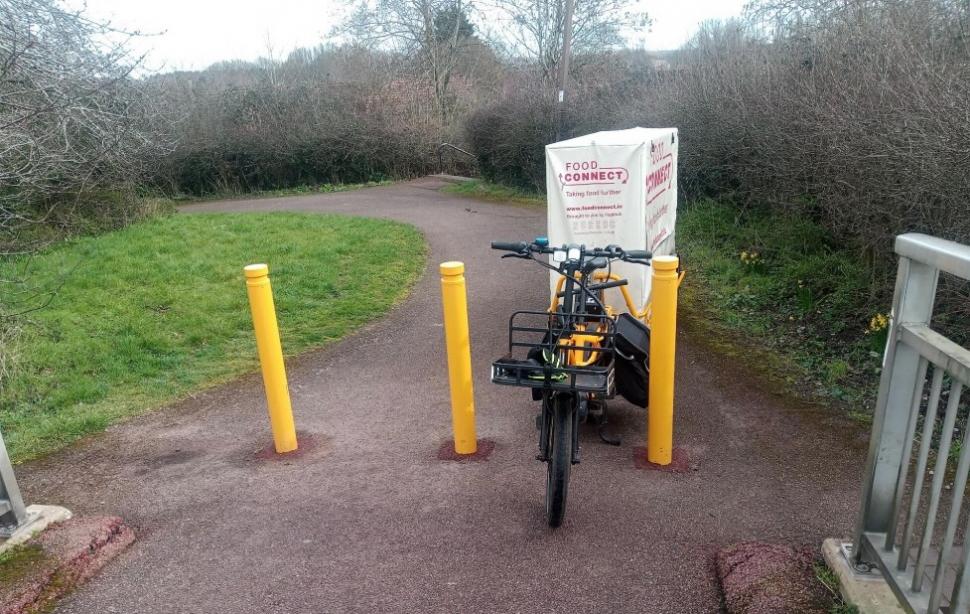- News
- Reviews
- Bikes
- Accessories
- Accessories - misc
- Computer mounts
- Bags
- Bar ends
- Bike bags & cases
- Bottle cages
- Bottles
- Cameras
- Car racks
- Child seats
- Computers
- Glasses
- GPS units
- Helmets
- Lights - front
- Lights - rear
- Lights - sets
- Locks
- Mirrors
- Mudguards
- Racks
- Pumps & CO2 inflators
- Puncture kits
- Reflectives
- Smart watches
- Stands and racks
- Trailers
- Clothing
- Components
- Bar tape & grips
- Bottom brackets
- Brake & gear cables
- Brake & STI levers
- Brake pads & spares
- Brakes
- Cassettes & freewheels
- Chains
- Chainsets & chainrings
- Derailleurs - front
- Derailleurs - rear
- Forks
- Gear levers & shifters
- Groupsets
- Handlebars & extensions
- Headsets
- Hubs
- Inner tubes
- Pedals
- Quick releases & skewers
- Saddles
- Seatposts
- Stems
- Wheels
- Tyres
- Health, fitness and nutrition
- Tools and workshop
- Miscellaneous
- Buyers Guides
- Features
- Forum
- Recommends
- Podcast
 A-frame barriers (before and after) in Church Village, Rhondda Cynon Taff (credit: Hamish Belding)
A-frame barriers (before and after) in Church Village, Rhondda Cynon Taff (credit: Hamish Belding)“Benefit of removing barriers far outweighs anti-social motorbike behaviour”: Cyclist calls for removal of barriers from cycle paths for greater accessibility
A recent removal of a barrier from a popular cycling route in south Wales has led to a cyclist and active travel campaigner highlighting the importance of such actions. He also called out the barriers on cycle paths for not being inclusive and being discriminatory towards people with mobility issues or adapted bicycles, while also criticising the “fear-mongering” of claims that there will be increased motorbike usage due to the removal of barriers.
Hamish Belding, who also serves as a Project Officer at cycling, walking and wheeling charity Sustrans, had borrowed a non-standard bicycle from charity Cardiff Pedal Power four years ago. He decided to cycle all the way from Llantrisant, a town in the county borough of Rhondda Cynon Taff, down to Cardiff, in order to do a case study on all the different sorts of barriers one would have to face.
Early on his journey, as he tried to navigate his way alongside the Church Village bypass and towards Tonteg, where he’s lived for the last eight years, he came across an A-frame barrier.
“I discovered with this particular barrier, I actually couldn't get through it without having to get off the bike and physically turn on its side and pull it through,” Belding told road.cc.
“That journey that I did back then in 2020 really opened my eyes to the fact that we’ve got this beautiful traffic-free path. But lots of people can't actually access it or it’s very difficult to do. And then since then, I have been putting pressure on the local authority to remove as many of these barriers as possible.”
ACCESS BARRIERS: For years this discriminatory access barrier has prevented #AccessForAll and finally it has been removed so community can access local traffic-free network! No more dismounting to wrestle my bike through it! Diolch @RCTCouncil 🚧💥👊🏻🚫🚲🏴🙌🏻 #BashTheBarrier pic.twitter.com/z29PlCnINQ
— Hamish Belding (@BikeWalkScoot) February 22, 2024
Since then, he has been involved in raising awareness by posting photographs on social media and talking to locals, as well as working with the Rhondda Cynon Taf active travel team to take down the barriers. He said: “I live locally. I have to go through that pretty much, most days of the week.
“I'm also aware that there's a number of residents who have mobility issues — a guy who has a mobility scooter, there's a special needs school nearby. They use the route to get through on things like trikes and other aids. But even standard bikes can't get through this barrier."
This particular barrier is on the five-mile-long Church Village traffic-free route, going alongside the bypass. However, Belding quickly came to the realisation that councils challenged the removal of barriers based on the perception that they are there to stop illegal motorbike or moped use, a view that is also echoed on social media by opponents.
He said: “Illegal motorbike use is a perception, there’s a lot of fear-mongering around it which may not actually reflect reality. Often the barriers are put in as an automatic sort of thing when paths are built and not in recognition of whether there's a problem or not. I know this area very well. I know that we don't have a motorbike problem here and the benefit of removing the barrier far outweighs any risk of antisocial motorbike behaviour.”
ACCESS BARRIERS: Took 3+ years but it CAN be done! Thank you @RCTCouncil for prioritising #AccessForAll and FINALLY taking action to remove this discriminatory access barrier on the link path to Church Village Community Route! 🚧⚠️🚫🚶♀️🧑🦽🚲🏴👏 #BashTheBarrier https://t.co/DvIkrYdwck pic.twitter.com/wou1Vraj6G
— Hamish Belding (@BikeWalkScoot) February 22, 2024
Belding told road.cc that local authorities along the Taff trail have taken action in removing barriers from the route in recent times — routes where motorbike use has previously been an issue. The results have been contradictory to what most might be coerced into believing.
“The findings we’re tending to see is that it doesn’t result in an increase in motorbike behaviour,” he said. “If anything, what we're seeing is more people accessing the path. And because there's more people using it, it’s not so attractive to people on motorbikes anymore. So we’re not seeing any real evidence to say it’s leading to increased motorbike use. If anything, it’s reducing that.”
“They're not preventing the motorbike use where it is prevailing, but what they are doing is preventing people who have adapted bikes, mobility aids, prams and other legitimate uses from accessing what is rightfully a community path, designed for people to go out and enjoy their local area and have an active lifestyle.”
He added that an important thing to do after the removal of a barrier is to monitor the area for improved accessibility and not a real increase in motorbike usage, and then use that as a model to convince the council for more barrier removals.
The only effective way to deal with illegal off-road motorbikes is to tackle the source by clamping down on illegal activity and imposing deterrents such as scrapping bikes! @swpolice have been doing some great stuff with #OperationRedMana! 🏍️🚫🚔🗑️🏴👍 pic.twitter.com/Kg9LdYJm5n
— Hamish Belding (@BikeWalkScoot) February 22, 2024
The Rhondda Cynon Taf County Borough Council has now, after more than three years of campaigning and negotiations, taken down the A-frame barrier in Church Village and replaced it with a minimum width gate, which doesn’t allow cars or quad-bikes to go through, but allows cycles, tandems, trikes, cargo bikes, as well as wheelchairs and mobility aids.
Belding said that after this barrier was removed, there have been instantaneous positive results, and he’s glad that the tide’s shifting towards more actions like this. He said that the Welsh Government has also recently released a special fund for every local authority in Wales to be able to specifically remove barriers.
“But there's still there's still a lot of barriers to be removed,” he added. “I often bring it up with the authorities just to say, ‘Look, there’s this one in this community? What's the reason for it still being there? Can we do something about it?’”
“We also have to acknowledge that you know, there's only so much they can do at any one time. They can't just suddenly remove them all overnight. But it’s really encouraging to see them take these decisions, often even having to face a bit of backlash in the short term. And when’s all said and done, all we want is to prioritise access for all users, over blocking a minority of users.”
Discriminatory barriers have been a topic cyclists have had to deal with for a long time. And it would be fair to say that the issue is still prevalent, despite campaigners and activists trying to raise awareness and convince councils.
Just two weeks ago, cyclist and Bolton Active Travel Forum Technical Review Group member Dr Grahame Cooper, as well as many others, called out the Bolton Council for the inadvertent impact such barriers can have on people, particularly those with disabilities who may use an adapted cycle.
“The real issue is that the barriers discriminate against people who use many types of cycle, including adapted cycles for users with disabilities, and the council's failure to follow due process,” he told road.cc.
Bearing a striking similarity, the council had claimed that the barriers were installed to prevent “anti-social behaviour”. And despite admitting that no equality impact assessment was carried out pre-installation, it believed it had still acted in accordance with design guidance.
In January 2022, York City Council removed the “shameful” barriers that blocked access to a cycle route, while Stockport Council in the same year decided to backtrack on barriers installed to, once again, combat anti-social behaviour.
Back in September a cyclist in Newcastle sent a legal letter to the council to challenge the lawfulness of barriers on a National Cycle Route which prevent him from accessing the path on his recumbent.
Most bizarrely was the case in Milton Keynes last year which saw ultracycling legend Steve Abraham criticise the local council's move to install bollards on a cycleway as it meant the route was no longer accessible for those using cargo bikes.
The bizarre bit comes from the fact the cargo bikes in question, used by Abraham in his work as a courier, were themselves supplied by the council.
Adwitiya joined road.cc in 2023 as a news writer after graduating with a masters in journalism from Cardiff University. His dissertation focused on active travel, which soon threw him into the deep end of covering everything related to the two-wheeled tool, and now cycling is as big a part of his life as guitars and football. He has previously covered local and national politics for Voice Wales, and also likes to writes about science, tech and the environment, if he can find the time. Living right next to the Taff trail in the Welsh capital, you can find him trying to tackle the brutal climbs in the valleys.
Latest Comments
- Born_peddling 1 sec ago
You very well could be right there, I used to live just off that route, they're some private businesses that back onto it disgruntled local maybe?...
- David9694 9 min 22 sec ago
Moment £35k car is submerged by sea after getting stuck on North West beach...
- wtjs 1 hour 1 min ago
High Probability Fantasist Alert
- Another Martin H 1 hour 5 min ago
"There are three cassette options: 11-44T, 10-44T or 10-36T, each of which will fit a traditional 11-speed HG-style driver body."...
- Capt Sisko 1 hour 33 min ago
" over 50% say more cameras would “change their behaviour” " It's a well known fact the carrot doesn't work for most motorist, but the big stick does.
- ktache 1 hour 48 min ago
That Katie Bower of the OHSP seems to have the right idea on some of the priorities of bicycle safety month.
- ktache 1 hour 55 min ago
Well done Cheshire constabulary.
- Stratman 2 hours 49 min ago
'Road test' is one of the boxes to be ticked in the checklist used by my local mechanic
- David9694 2 hours 57 min ago
A round up ...



Add new comment
4 comments
But the bike has a motor.....
And ???
These barriers have been illegal since the 2010 equalities act because they discrimate agains the less able. Preventing disabled folk from using public paths is I'd say more anti social than muppets on motorbikes.
These links have useful information on how to get councils to remove them.
Barrier removal Toolkit
Heavy Metal Handcyclist
Letter template
Letter template 2
Thank-you for this story - it is good to see some positive narrative pieces, as well as the sensational particular cases.
(Now we need some about dodgy skiddy & innaccessible surfaces on Greenways !)